Zanja Madre - LA's Original Aqueduct
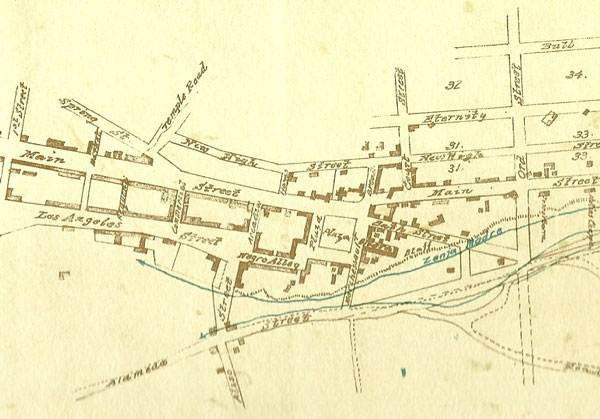 |
|
| (1868)*^ - This manuscript map traces the path of the essential lifeline of early Los Angeles: the Zanja Madre, or Mother Ditch, prepared by cartographer William Moore. |
Historical Notes The Zanja Madre (Mother Ditch) is the original aqueduct that brought water to the Pueblo de Los Angeles from the Rio Porciuncula (Los Angeles River). It was originally an open, earthen ditch which was completed by community laborers within a month of founding the pueblo in 1871. The ditch underwent many alterations over the years and was still in use until the early 20th century. |
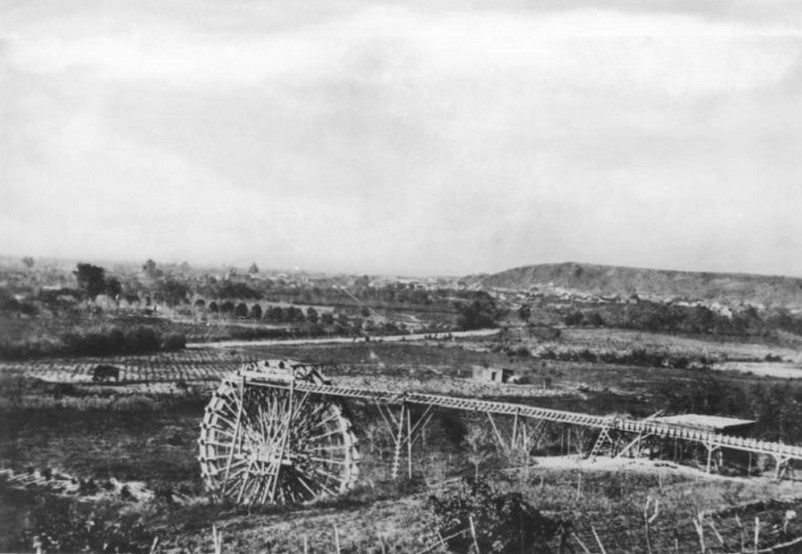 |
|
| (1863)* - A water wheel on the Los Angeles River at start of Zanja Madre. The river has been the life-source of Los Angeles since it was settled in 1781. |
Historical Notes The water wheel seen above was 40 feet in diameter. It was used to raise a portion of the Los Angeles River water supply to a height permitting gravity flow to homes, fields and storage. In 1857, William Dryden was granted a franchise by the City Council to construct a system to provide a water supply. Under this system a brick reservoir was built in the center of the plaza to store the water brought to it by the Zanja Madre. A water wheel was also constructed to lift the water from the river to the Zanja Madre. Water then was distributed to a number of houses along the principal streets through a system of wooden pipes. Click HERE to read more about William Dryden. |
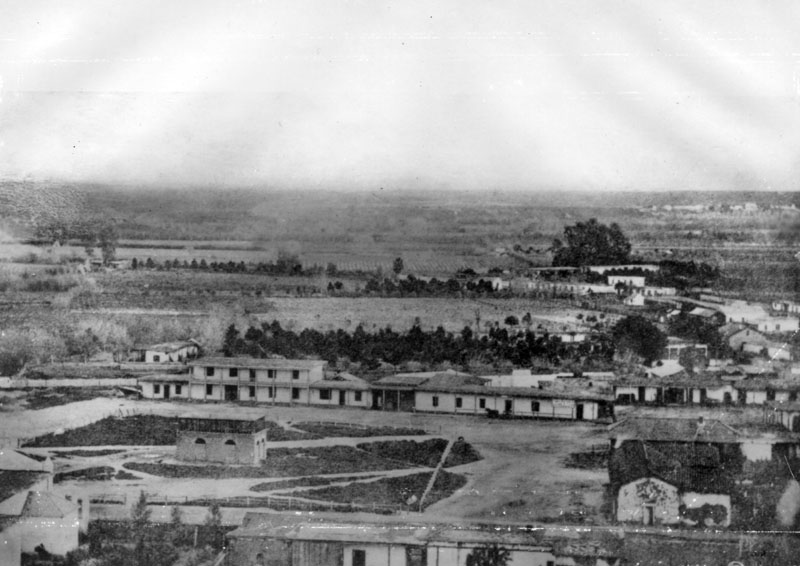 |
|
| (ca. 1858)* - This is the earliest known photograph of the Los Angeles Plaza. There is a square main brick reservoir in the middle of the Plaza, which was the terminus of the town's historic lifeline: the Zanja Madre ('Mother Ditch'). The reservoir was built in 1858 by the LA Water Works Company. |
Historical Notes In 1857 William Dryden and his newly incorporated water company, Los Angeles Water Works Co., erected a forty foot water wheel to lift water from the LA River to the city's main water ditch, the Zanja Madre. He then constructed a large brick and wood storage tank (in 1858) in the center of the city plaza as seen above. It would remain there for about 10 years and then be replaced by a fountain. Afterward, water would continue to be stored in other tanks on the periphery of the plaza as well as in other nearby reservoirs (Click HERE to see more in Early LA Water Reservoirs). |
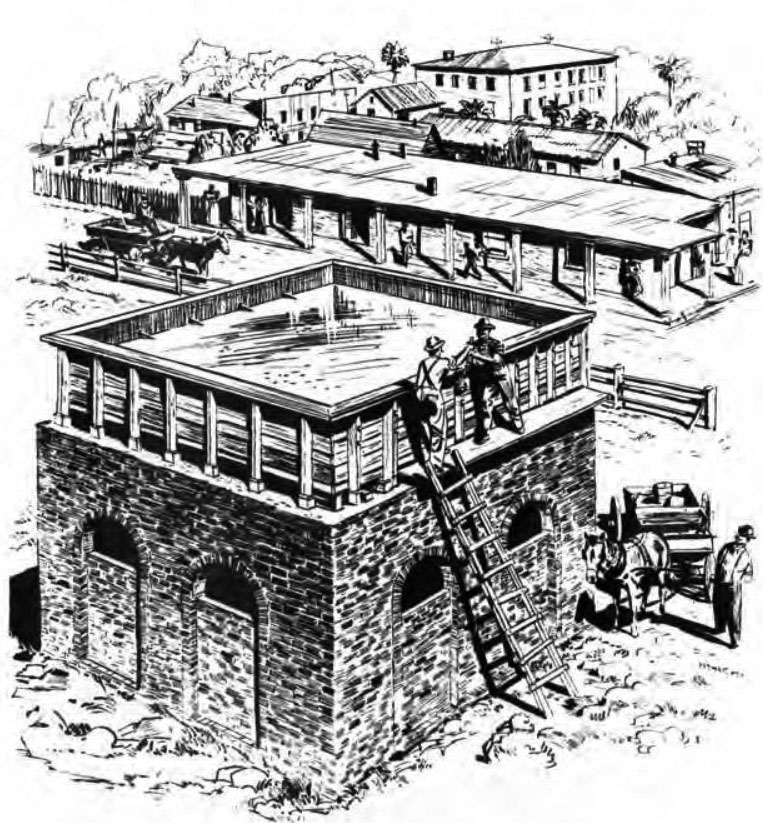 |
|
| (ca. 1860)* - Sketch of the first stone reservoir in Los Angeles. Fed by the Zanja Madre, it would remain in the center of the LA Plaza for about 10 years and then replaced by a fountain. |
Historical Notes The conversion from total dependence on the zanja system for domestic water to an underground iron pipe water system began in 1867. Jean Louis Sansevain, a Frenchman who owned an extensive vineyard and winery on Aliso Street, was authorized by the City Council to lay 5,000 feet of iron pipe and to build a dam and reservoir. Discouraged by repeated failures, Sansevain the following year offered his lease to a group of individuals who formed a private corporation known as the Los Angeles Water Company.^ |
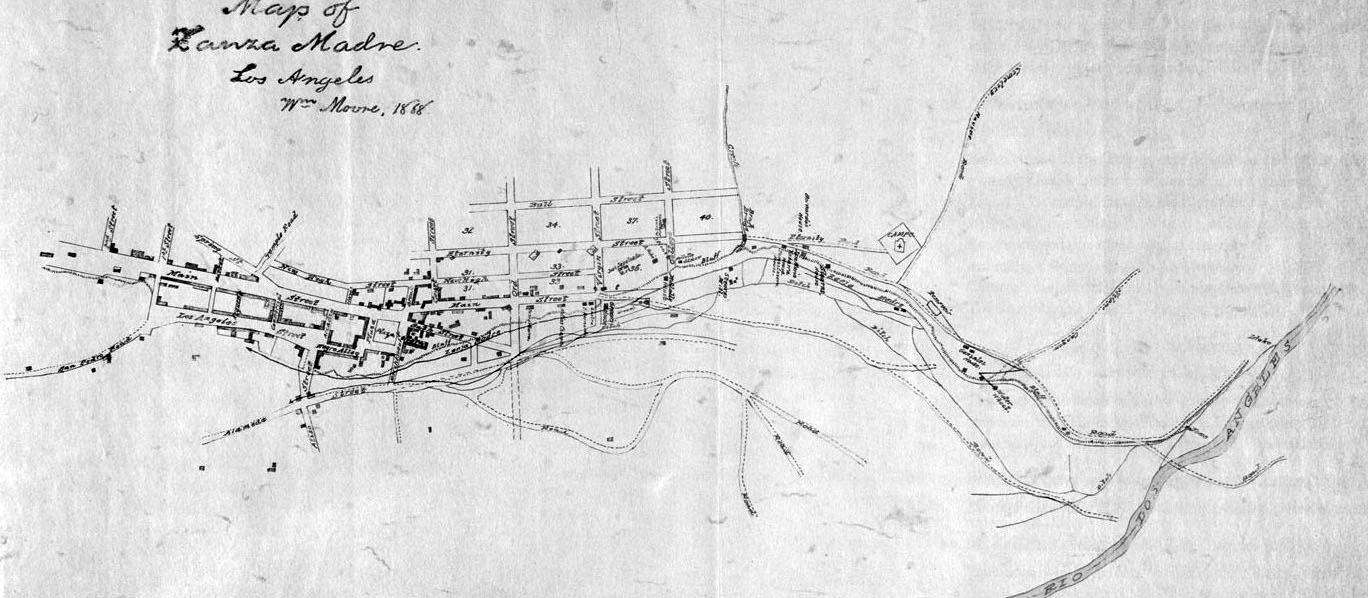 |
|
| (1868)*^ - Map showing the route of the Zanja Madre irrigation system prepared by William Moore. |
Historical Notes The Zanja Madre is shown here from the river at the right edge of the map, running along the bluffs in the proximity of current day North Broadway, completely open to the elements. A few years after this rendering, a brick tunnel enclosed the Zanja Madre in an attempt by the Common Council and the Los Angeles City Water Company to preserve the precious water flowing down from the river. The map includes the Campo Santo cemetery (the second one) at the end of Eternity Street, the water wheel that propelled the flow toward the pueblo, and the homes of pioneers like Jose Sepulveda, Abel Stearns, and Bernardo Wilson.^^ |
.gif) |
|
| (1873)*# - Ruxton Survey of the Central Pueblo. This oversize plat shows the plaza area in 1873, including the center of town with the early buildings and the zanza madra (zanja madre) which was LA's original water aqueduct and lifeline. The map also shows the streets in use and the early owners of many of the properties. The layout of the plaza itself, however, is shown as it appeared before the change in landscaping in the prior two years before it became rounded. |
.jpg) |
|
| (ca. 1900)* - Washing clothes at the Zanja Madre. View of three women and two children washing clothes at the Zanja Madre. A few small buildings, visible throughout the image, appear to serve as barns. |
Historical Notes The Zanja Madre system ran from the Los Angeles River for more than a mile to the plaza, where the Olvera Street marketplace is now. Residents not only got their drinking water from the ditch, but the surrounding vineyards and farmland were also irrigated by its water. |
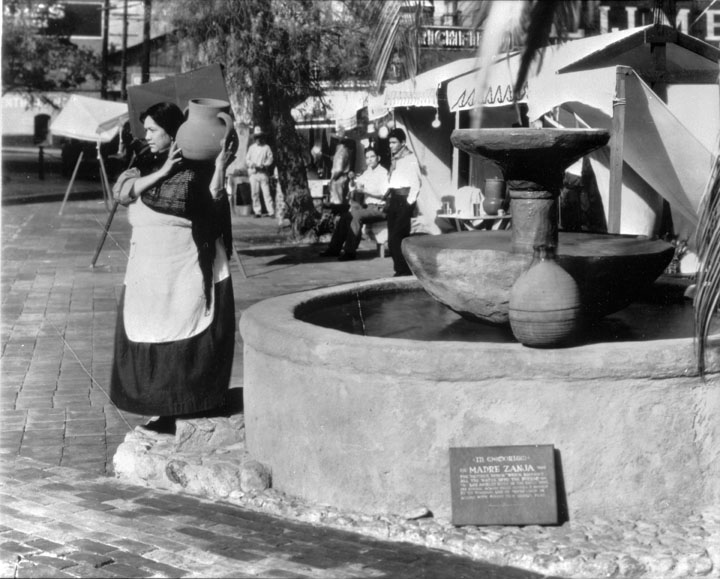 |
|
| (n.d.)^ - Woman carrying a water jar from the fountain at Olvera Street. |
.jpg) |
|
| (ca. 1890)*^*– View looking northwest showing an unpaved Figueroa Street. Note the water-filled ditch (Zanja) on the west side of Figueroa with walkway crossings in front of each of the large homes. A two-story Victorian-style house is visible to the left, followed further to the right by a one-story clapboard-sided home with a porch, to the left of which a windmill is situated. |
Historical Notes The Zanja (Spanish for ditch) was the original water supply channel for the southwest part of the city. It was built in 1868 and rebuilt in 1885 with concrete. By the 1880s there were 10 zanjas that covered 93 miles.^ |
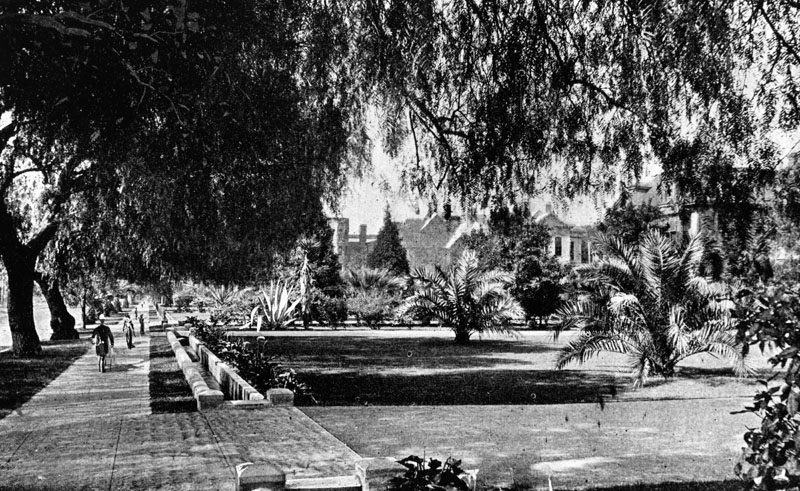 |
|
| (ca. 1895)* - View of Figueroa Street near 23rd Street, showing the Zanja water supply channel and people walking on the sidewalk. The houses have massive lawns. |
Historical Notes The original water supply for Los Angeles was delivered in open trenches despite serious problems with public dumping into the trenches. In the 1880s and 1890s gradually piped water was introduced into more expensive neighborhoods, and the zanjas were used for irrigation only. The zanjas served the city until 1902, when they were replaced with a system of underground pipes.^ |
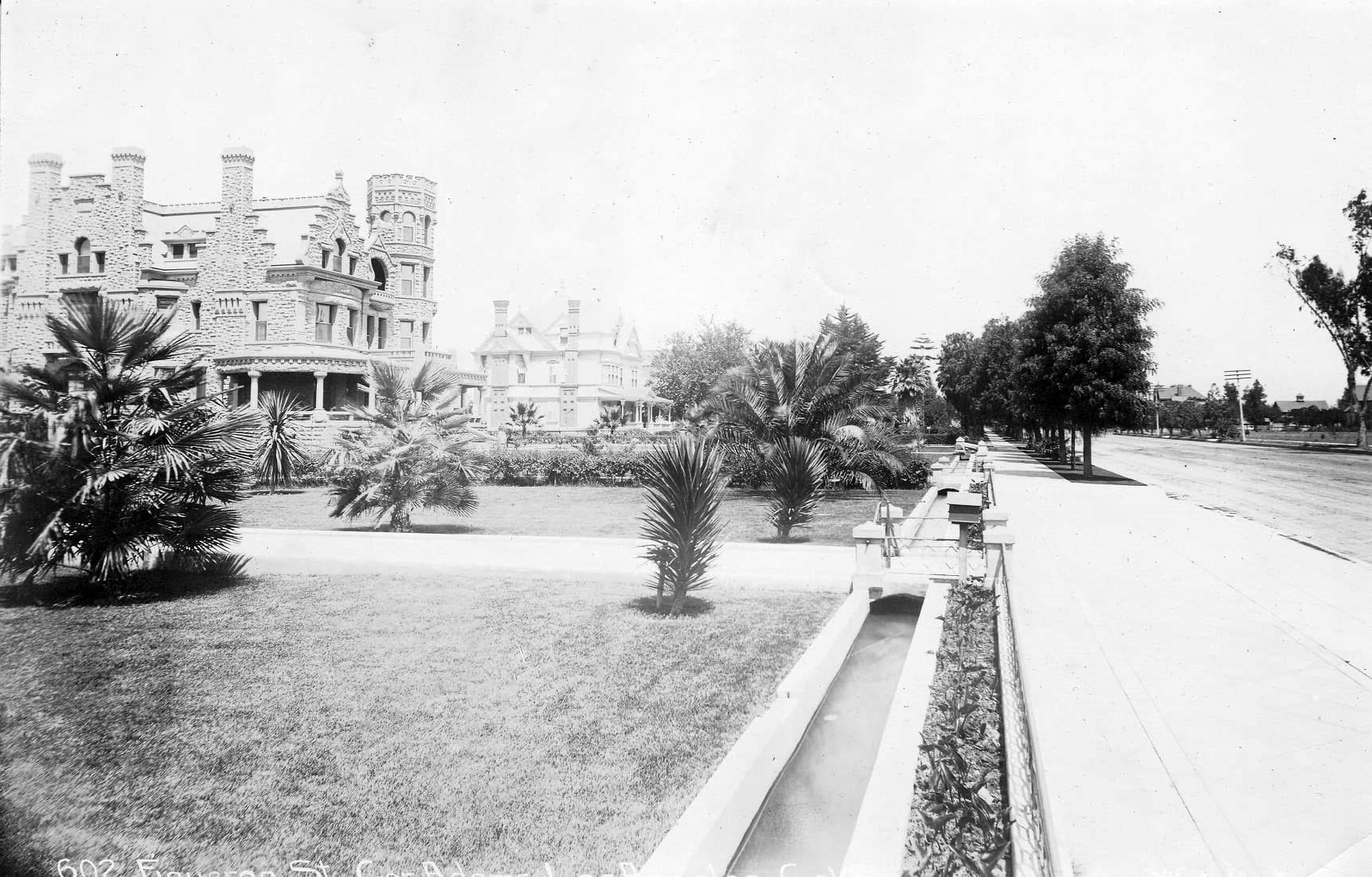 |
|
| (1890s)^.^ – View looking north showing the Stimpson House (2421 S. Figueroa) with a water ditch (zanja) running between parallel to Figueroa at the property line. |
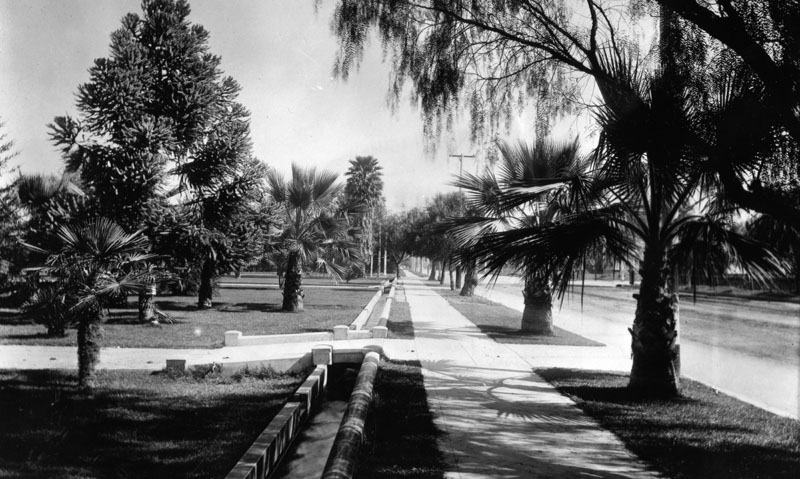 |
|
| (ca. 1900)* - Zanja on Figueroa Street near Washington Boulevard was the original water supply channel for the southwest part of the city. |
Historical Notes In 1903, William Mulholland presented an end-of-year report to the Los Angeles' newly formed Board of Water Commissioners. "The zanja system has made its usual poor showing for the year," he wrote. "It would certainly be the greatest folly to spend any more money in new construction on this system." The commission took heed, and the next year the zanjas were offcially abandoned. This closed a chapter in the city's history that stretched from the founding of El Pueblo in 1781 to the turn of the 20th century. For more than a century the zanja system, that brought water from the LA River to the homes and fields of Los Angeles, was the lifeblood of the region. At its height in 1888, 52 miles of zanjas, half open earth and half concrete, ran within the city limits. An additional 40 miles of zanjas ran outside the city proper. Controlled by the local government, the water that flowed in these zanjas enabled life, and occasionally death, to flourish in Los Angeles.* |
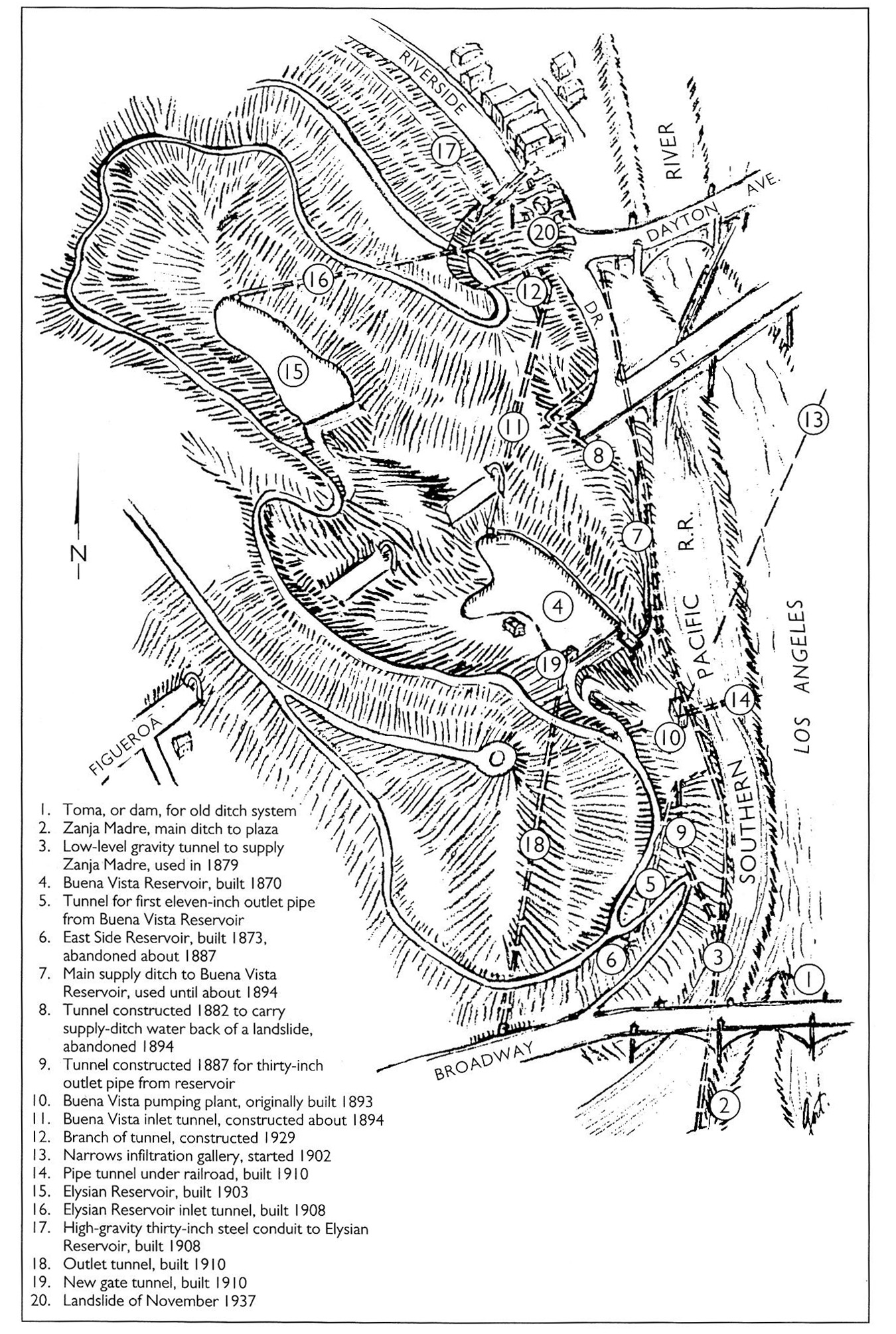 |
|
| (1938)^* - Map of the Elysian Park area showing waterworks structures dating from Zanja Madre days to 1937. |
The Uncovering of a Section of the Zanja Madre
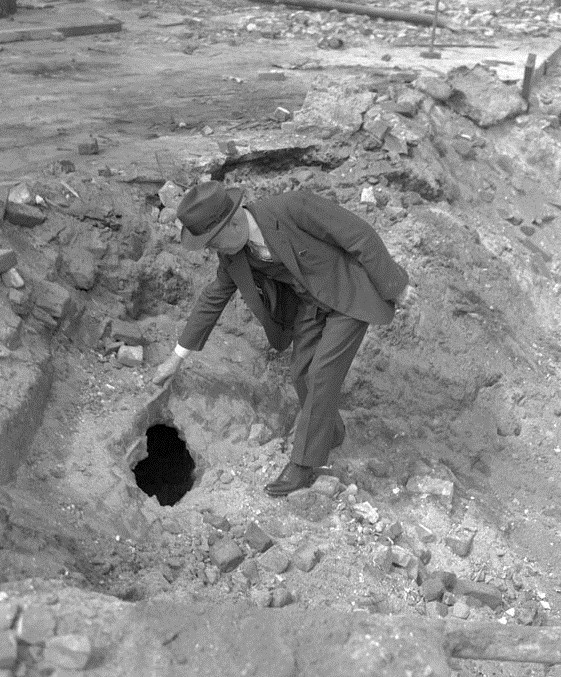 |
|
| (1939)* - William W. Hurlbut points to hole punched in Zanja Madre. |
(1939) - LADWP Historic Archive
A colorful pageant on May 3, 4, and 5, 1939 marked the formal opening of the new Union Station. To permit widening of the approach to the station, the first home of the Department of Water and Power, corner of Marchessault and Alameda Streets, was demolished. During wrecking operations, State Highway engineers uncovered a section of the Zanja Madre, original water distribution system of the City when it was a pueblo. It is thought that water entered the Zanja from the Los Angeles River at a point near the present Broadway Bridge. W. W. Hurlbut, engineer of water works, points to a hold punched in the primitive water carrier. The four foot diameter brick conduit ran diagonally underneath the old Department building and appeared still to be in an excellent state of preservation. ^
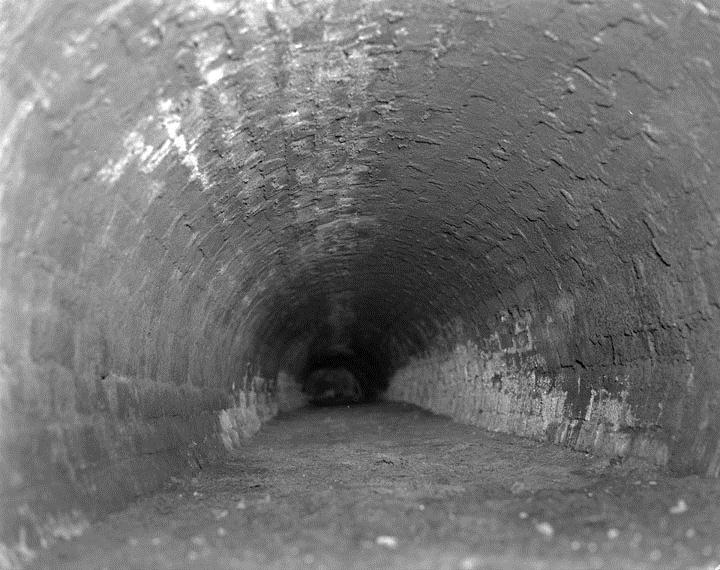 |
|
| (1939)* - Interior of Zanja Madre uncovered during wrecking of first Department of Water and Power building - The old “Zanja Madre” or mother ditch, carrier of much of Los Angeles’ water supply during the middle of the last century, has again became the subject of historical discourse. This time because workmen, while excavating on Olvera Street, came across traces of a small redwood bridge which used to cross it. |
Remnants of the Zanja Madre
.jpg) |
|
| (n.d.) - Remnant section of the early brick canal (located west of Union Station) |
Historical Notes As the population grew it became necessary to protect the Zanja Madre from the pollution of the local environment – animals, trash, even an occasional drunk falling in. Consequently, the City Council provided for the zanja to be bricked over so the water would flow through unpolluted. Today, you can see a remnant of the bricked-over Zanja Madre in the area behind the Gold Line station in Chinatown, preserved by the Metro rail system. Also, in the heart of Olvera Street, in the DWP two floor display, at the lower level there is a part of the Zanja Madre preserved there, too. |
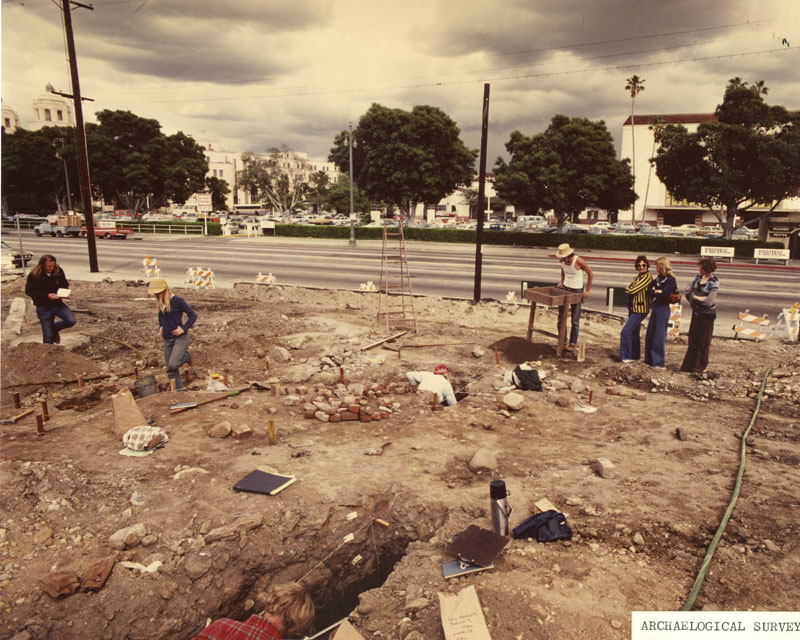 |
|
| (ca. 2000)* - Scientists working on an archaeological survey across Alameda Street west of Union Station at the time of the discovery nearby of a part of the Zanja Madre (early water canal). |
Zanja Madre Final Appearance

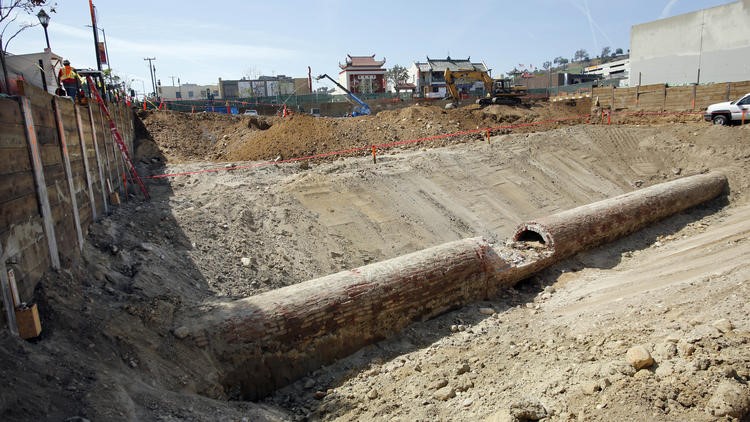 |
|
| (2014)^* - View of another section of L.A.'s original Zanja Madre unearthed at a construction site located on the northeast corner of Broadway and College Street in Chinatown. |
Historical Notes In April 2014, construction crews unearthed a section of the Zanja Madre while excavating for a new five-story mixed used housing project located on the northeast corner of North Broadway and College Street, 900 N. Broadway. |
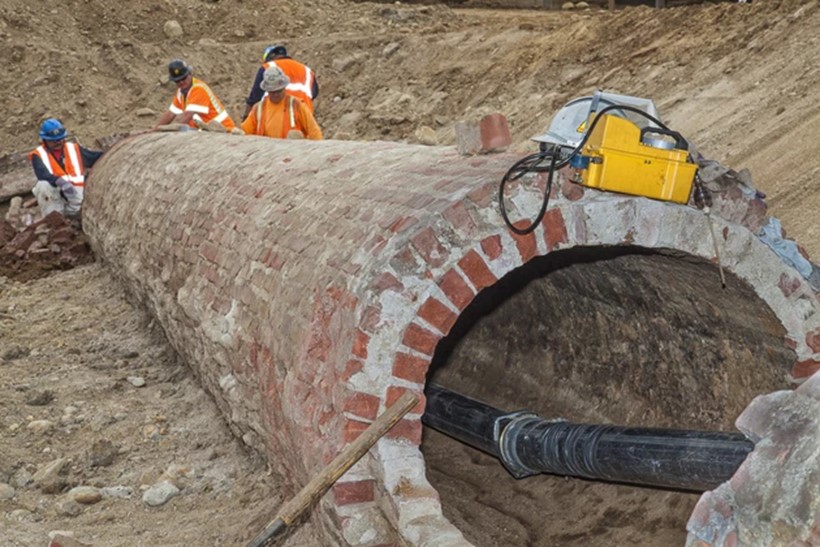 |
|
| (2014)* – Close-up view showing construction workers unearthing a section of the Zanja Madre at the site where Little Joe's Restaurant once stoore, corner of Broadway and College. |
Historical Notes The famous Little Joe’s Restaurant was located at this corner (Broadway and College) in a building that stood for over 100 years. In December of 2013, developer Forest City Enterprises started demolishing Little Joe's to make way for a five-story project (Blossom Plaza) that will link Broadway with the elevated Chinatown Metro Rail station above North Spring Street to the east. Blossom Plaza will have 237 residential units, including 53 apartments where rents will be reduced for low-income tenants. It will also house 175 parking spaces open to the public and a landscaped courtyard next to the Metro Rail stop.^* |
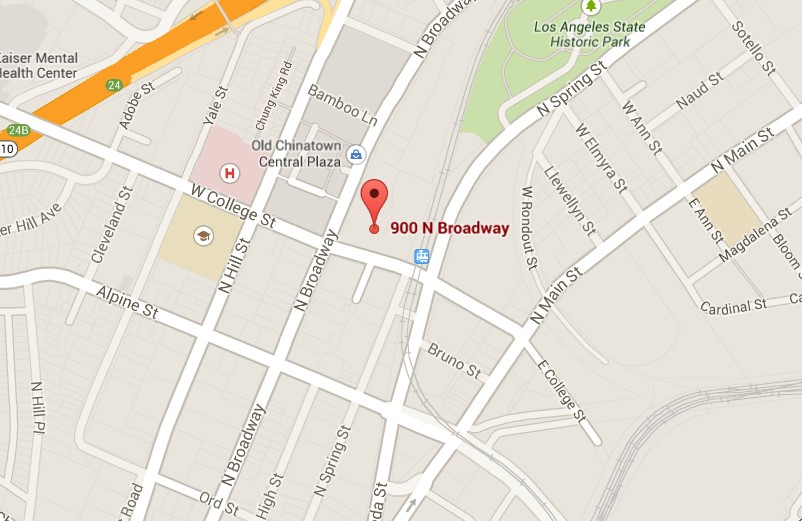 |
|
| (2014) – Google Map view showing location of an original Zanja Madre segment at 900 N. Broadway. |
< Bricks from the Zanja Madre
Course of Zanja Madre Through Today's Olvera Street
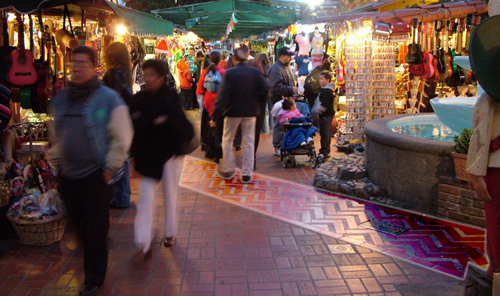 |
|
| (2006)** - Photo of Olvera Street with enhancement of the brickwork showing the course of the Zanja Madre through the pueblo. Note the Zanja passes right alongside a fountain which would be typical.** |
 |
|
| (2014)#* - View showing the path of the Zanja Madre (foreground) as it crosses Olvera Street and then runs under the Hammel Building (right). |
Historical Notes A new LADWP Historical Exhibit is scheduled to open in the near future. Located in the Hammel Building (seen above), it will include a viewing platform from which the public can see an exposed portion of the original Zanja Madre. Click HERE for more on the new LADWP Historical Exhibit. |
Click HERE to read more about LA's Early Water Works System from the LADWP Historic Archive. |
* * * * * |
Please Support Our CauseWater and Power Associates, Inc. is a non-profit, public service organization dedicated to preserving historical records and photos. Your generosity allows us to continue to disseminate knowledge of the rich and diverse multicultural history of the greater Los Angeles area; to serve as a resource of historical information; and to assist in the preservation of the city's historic records.
|
History of Water and Electricity in Los Angeles
More Historical Early Views
Newest Additions
Early LA Buildings and City Views
* * * * * |
References and Credits
* DWP - LA Public Library Image Archive
*^ LA Public Library Image Archive
^^ Los Angeles Magazine: Zanja Madre 1868
^* Los Angeles Times: Zanja Madre; Little Joe's Restaurant
*# Picture Gallery of Los Angeles History
#* Redlands Sister City: Discover Olvera Street
*^*Flickr.com: Michael Ryerson
< Back
Menu
- Home
- Mission
- Museum
- Major Efforts
- Recent Newsletters
- Historical Op Ed Pieces
- Board Officers and Directors
- Mulholland/McCarthy Service Awards
- Positions on Owens Valley and the City of Los Angeles Issues
- Legislative Positions on
Water Issues
- Legislative Positions on
Energy Issues
- Membership
- Contact Us
- Search Index